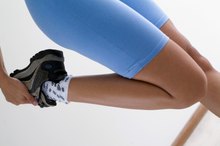How to Treat a Hamstring Cramp
Your hamstring is a muscle at the back of your thigh that is used nearly every time you move your leg 1. When a muscle cramps, it locks up, causing immobility and severe pain 1. Hamstring cramps usually occur when you are either engaged in strenuous physical activity or sleeping 1. It is normal to feel tenderness and discomfort for an entire day after a severe cramp in your hamstring. You may not be able to dispense with hamstring cramps altogether, but you can treat them by taking steps to ease the cramp and prevent future cramping as best you can 1.
If you are experiencing serious medical symptoms, seek emergency treatment immediately.
Easing the Cramp
Relax your leg as soon as you feel the cramp coming. Your first response may be to tighten your leg muscles and pull your leg as close to your body as possible, but this has the potential to increase the severity and duration of the cramp.
Hand Cramps Associated With Vitamin Deficiencies
Learn More
Stretch your leg out slowly in front of you and curl your toes. Putting the injured muscle and surrounding muscles to work after being in a relaxed state can loosen the cramp 1. Stretching also reduces pressure on the hamstring and eases the pain.
Attempt a more targeted stretch if basic stretching does not relieve the pain. Place the ankle of the leg that is cramping behind the ankle of your other leg and push hard. The resulting pressure should alleviate the cramp.
How to Recover From Bad Running Leg Cramps
Learn More
Massage the muscle with your hands and apply an ice pack as soon as possible 1.
Use a topical anti-inflammatory to prevent swelling and help minimize discomfort when the cramp passes.
- Relax your leg as soon as you feel the cramp coming.
- Massage the muscle with your hands and apply an ice pack as soon as possible 1.
Preventing Cramps
Drink plenty of water. You can be dehydrated and not realize it--especially if you are physically active. Dehydration can contribute to muscle cramps 1.
Take multivitamins that contain potassium. Hamstring cramps are sometimes caused by a potassium deficiency 1.
Eat a healthy and balanced diet. An electrolyte deficiency can contribute to muscle cramps 1. While some sports drinks contain electrolytes, there is no replacement for regular healthy meals.
Increase your activity level slowly over a period of time. Overexerting your body when it is not accustomed to strenuous activity is a direct cause of many muscle cramps 1. By gradually increasing your activity level you allow your body time to adjust.
Stretch daily. Even if you do not work out regularly, daily stretching serves to condition your muscles and prevent cramps 1. If you do work out, stretch before and after exercise.
See a doctor. If the cramping is frequent and all preventative measures fail, it may be the result of an underlying medical condition.
Tips
The color of your urine will indicate whether you are properly hydrated. If you are hydrated, your urine should be pale yellow or colorless. Dark urine indicates dehydration. If your hamstring cramps occur mostly at night, take a hot shower immediately before going to bed to relax your muscles.
Warnings
Seek medical attention immediately if bruising occurs or if you feel continuous muscle spasms. This may indicate a torn hamstring.
- You can be dehydrated and not realize it--especially if you are physically active.
- Even if you do not work out regularly, daily stretching serves to condition your muscles and prevent cramps 1.
Related Articles
References
- Muscle Cramps
- Young G. Leg cramps. BMJ Clin Evid. 2015;2015
- Jahic D, Begic E. Exercise-associated muscle cramp-doubts about the cause. Mater Sociomed. 2018;30(1):67-69. doi:10.5455/msm.2018.30.67-69
- Waters TR, Dick RB. Evidence of health risks associated with prolonged standing at work and intervention effectiveness. Rehabil Nurs. 2015;40(3):148-65. doi:10.1002/rnj.166
- Skogar O, Lokk J. Pain management in patients with Parkinson's disease: challenges and solutions. J Multidiscip Healthc. 2016;9:469-479. doi:10.2147/JMDH.S105857
- Hallegraeff J, De greef M, Krijnen W, Van der schans C. Criteria in diagnosing nocturnal leg cramps: a systematic review. BMC Fam Pract. 2017;18(1):29. doi: 10.1186/s12875-017-0600-x
- Mcdermott MM. Lower extremity manifestations of peripheral artery disease: the pathophysiologic and functional implications of leg ischemia. Circ Res. 2015;116(9):1540-50. doi:10.1161/CIRCRESAHA.114.303517
- Blyton F, Chuter V, Walter KE, Burns J. Non-drug Therapies For Lower Limb Muscle Cramps. Cochrane Database Syst Rev 2012; 1:CD008496.
- Grandner MA, Winkelman JW. Nocturnal leg cramps: Prevalence And Associations With Demographics, Sleep Disturbance Symptoms, Medical Conditions, And Cardiometabolic Risk Factors. PLoS One 2017; 12:e0178465.
- Allen RE, Kirby KA. Nocturnal Leg Cramps. Am Fam Physician 2012; 86:350
- American Academy of Sleep Medicine. Sleep Related Leg Cramps. In: International Classification of Sleep Disorders, 3rd ed., American Academy of Sleep Medicine, Darien, IL 2014. p.299-303.
- Maquirriain J, Merello M. The Athlete with Muscular Cramps: Clinical Approach. J Am Acad Orthop Surg 2007; 15:425.
Tips
- The color of your urine will indicate whether you are properly hydrated. If you are hydrated, your urine should be pale yellow or colorless. Dark urine indicates dehydration.
- If your hamstring cramps occur mostly at night, take a hot shower immediately before going to bed to relax your muscles.
Warnings
- Seek medical attention immediately if bruising occurs or if you feel continuous muscle spasms. This may indicate a torn hamstring.
Writer Bio
Ciele Edwards holds a Bachelor of Arts in English and has been a consumer advocate and credit specialist for more than 10 years. She currently works in the real-estate industry as a consumer credit and debt specialist. Edwards has experience working with collections, liens, judgments, bankruptcies, loans and credit law.









